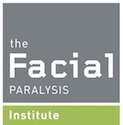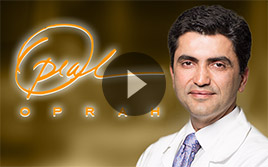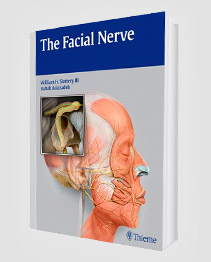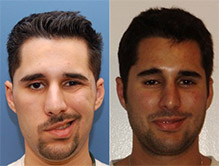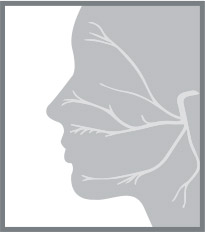What Is Facial Paralysis Rehabilitation?
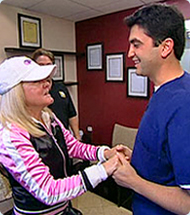
As this condition can affect people differently, developing a clear understanding of facial paralysis is key. If an individual understands their facial paralysis symptoms, he or she can, with the help of a medical professional, identify the root cause of the symptoms and receive appropriate treatment.
From here, this individual can begin to recover from their symptoms with their personalized treatment and minimize their risk of long-lasting facial paralysis.
Facial nerve paralysis can occur for many reasons, including:
- Bell’s palsy
- Acoustic neuroma
- Parotid cancer
- Cosmetic or surgical procedures resulting in accidental injury of the facial nerve
Regardless of why facial paralysis occurs, it is important to treat the condition in its early stages. Otherwise, facial paralysis can impact an individual’s ability to smile, frown, and produce other natural facial expressions. It can also cause facial asymmetry.
Once facial paralysis is treated, the rehabilitation process begins. At this time, a patient may benefit from a myriad of facial paralysis rehabilitation techniques.
How Does Facial Paralysis Rehabilitation work?
The goal of facial nerve rehabilitation is to develop a treatment that will result in increased facial mobility and expression for that patient. A specialized therapist will educate the affected individual in appropriate exercises as well as establish a treatment regimen to maximize facial movement.
Over time, as the patient commits to their unique treatment plan, they may begin to see improvement of their symptoms, potentially increasing the likelihood of an improved outcome. These exercises and courses of treatment are often an important addition to many forms of facial nerve paralysis rehabilitation, both surgical and nonsurgical.
Common Facial Paralysis Rehabilitation Techniques
Research indicates that several techniques for facial nerve rehabilitation can be safe and effective following facial paralysis treatment. These techniques include:
1. Neuromuscular Retraining (NMR)
NMR involves the use of exercises to improve facial muscle coordination. During training, a physical therapist teaches a patient a series of facial muscle exercises. The patient initially performs these exercises under their physical therapist’s supervision. Then, the patient learns how to complete the exercises on their own.
An NMR regimen is tailored to each patient. The goal of these NMR exercises is to help a patient increase facial muscle coordination to the point where he or she can naturally smile, frown, and make other facial expressions.
The effectiveness of NMR for facial paralysis rehabilitation depends on the patient’s commitment. If a patient completes NMR exercises according to a physical therapist’s plan, he or she increases the likelihood of successful rehabilitation.
NMR therapy results are monitored carefully. A physical therapist tracks their patient’s progress in the weeks and months of rehabilitation. If any issues arise during rehabilitation, an NMR treatment plan can be modified.
2. Electromyography (EMG) Biofeedback
EMG biofeedback has been shown to benefit patients during their recovery from facial paralysis surgery. It involves the use of visual and sound signals as facial nerve rehabilitation techniques. These signals are used to monitor facial muscle activity.
With EMG biofeedback, electrodes are applied to a patient’s facial muscles. They generate visual or sound feedback signals in response to activated muscles across the face. Electrodes can then relax certain facial muscles to bolster facial symmetry and improve facial muscle coordination.
EMG biofeedback is generally considered safe for most patients. However, patients with certain medical conditions may not qualify for EMG biofeedback as part of their rehabilitation from facial paralysis. These medical conditions can include, but are not limited to, people with heart rhythm irregularities or skin conditions that would be made worse by the attaching of the electrodes required for EMG biofeedback therapy.
Those who are considering treatment for facial paralysis should consult with a doctor before beginning EMG biofeedback. The doctor can then determine if a patient is a good candidate for EMG biofeedback or if other rehabilitation options would be more helpful. After a patient undergoes an evaluation, they can receive a personalized treatment plan.
3. Manual Massage
A physical therapist can use several massage techniques to reduce facial muscle tightness and boost flexibility and range of motion. Like NMR, a physical therapist will be present to teach and can perform manual massage on a facial paralysis patient. Eventually, the patient will learn massage techniques from their physical therapist and perform them on their own.
What Are the Best Facial Paralysis Rehabilitation Techniques?
Facial nerve paralysis symptoms vary, and facial palsy patients can experience symptoms that range from mild to severe. The best treatment for facial paralysis depends on the unique circumstances of each facial palsy patient. Proper rehabilitation of the facial nerve can begin after a thorough evaluation with an experienced medical professional.
Several treatment options are available if facial synkinesis symptoms linger for months after onset. By meeting with Dr. Babak Azizzadeh of The Facial Paralysis Institute, an individual can explore a wide range of facial paralysis treatments.
Dr. Azizzadeh is a Harvard-trained and dual board-certified facial plastic and reconstructive surgeon with many years of expertise in the field of facial paralysis treatment. He recommends patients consult with him if they have been experiencing facial paralysis symptoms for eight months or longer. In these instances, Dr. Azizzadeh can conduct an assessment to evaluate the severity of his patient’s symptoms, identify the root of their cause, and offer a custom treatment recommendation.
What Is the Best Treatment for Facial Paralysis?
Dr. Azizzadeh will recommend different treatments according to the severity of the patient’s symptoms. One treatment option that he may recommend for central facial palsy is Botox. Botox can ease the tension on the affected side of the face and helps relax possibly overactive muscles, reducing involuntary spasming. Botox injections deliver facial paralysis symptom relief that can last up to four months.
For patients coping with severe symptoms, Dr. Azizzadeh may recommend facial paralysis surgery. Some patients may qualify for selective neurolysis, which can be used to treat partial facial paralysis, synkinesis, and Bell’s palsy. Other patients may be good candidates for other surgical procedures.
Patients can meet with Dr. Azizzadeh to determine if Botox or surgery is the optimal treatment for facial palsy symptoms. Dr. Azizzadeh offers in-person and virtual consultations to assess his patient’s symptoms. He can then determine what treatment option can help his patient achieve long-lasting symptomatic relief.
How Does Dr. Azizzadeh Assess a Patient’s Facial Paralysis Symptoms?
Dr. Azizzadeh conducts extensive testing to analyze a facial paralysis patient. Common tests include:
- Laboratory tests
- Thyroid test
- Ear, nose, and throat evaluation
- Computed tomography (CT) scan
- Magnetic resonance imaging (MRI) scan
Dr. Azizzadeh wants each patient to understand the cause of his patient’s facial paralysis symptoms. He uses testing to verify the cause of these symptoms and develop an appropriate treatment plan for his patient.
Furthermore, Dr. Azizzadeh works diligently on behalf of his patients. Dr. Azizzadeh ensures that a treatment plan accounts for his patient’s short- and long-term health. He also verifies that a treatment can be administered without putting his patient’s health in danger and will only recommend a treatment if he believes that it can be performed safely.
Dr. Azizzadeh meticulously follows and reviews his patient’s rehabilitation process, as well. He closely monitors his patients following a facial paralysis treatment, working with the patient to achieve the most effective results for the patient’s unique situation. If a patient has concerns or questions at any point during the recovery period, Dr. Azizzadeh can respond to them.
Can Central Facial Paralysis Clear Up on Its Own?
Facial paralysis recovery often begins within about two weeks of symptomatic onset. At this point, an individual starts to regain the ability to move the muscles on the paralyzed side of the face.
Within about three months, an individual’s facial paralysis symptoms should disappear. From here, an individual can enjoy full facial muscle movement. This individual shows no visible signs of facial paralysis and can produce natural facial expressions without any limitations.
In the event that facial palsy symptoms do not resolve, a patient should consider different treatment options. If one or more treatments have been used but failed to deliver relief from facial paralysis symptoms, additional help may be necessary. At that time, it can be helpful to meet with Dr. Azizzadeh.
Dr. Azizzadeh understands the challenges associated with treating central facial palsy. He dedicates time, energy, and resources to understand his patient’s facial paralysis symptoms. After thorough review, Dr. Azizzadeh will be able to assess his patient’s progress toward recovery.
Make a Meaningful Recovery from Central Facial Palsy
No one should be forced to deal with central facial palsy symptoms for an extended period of time. With help from Dr. Azizzadeh, an individual can treat their facial paralysis symptoms and reduce their severity.
Dr. Azizzadeh offers consultations to those who have been dealing with long-term facial paralysis symptoms. To request a consultation, please contact us online or call us today at (310) 657-2203.
Request your consultation with Dr. Azizzadeh today
Call us at (310) 657-2203 to schedule an appointment.
Schedule a Consultation